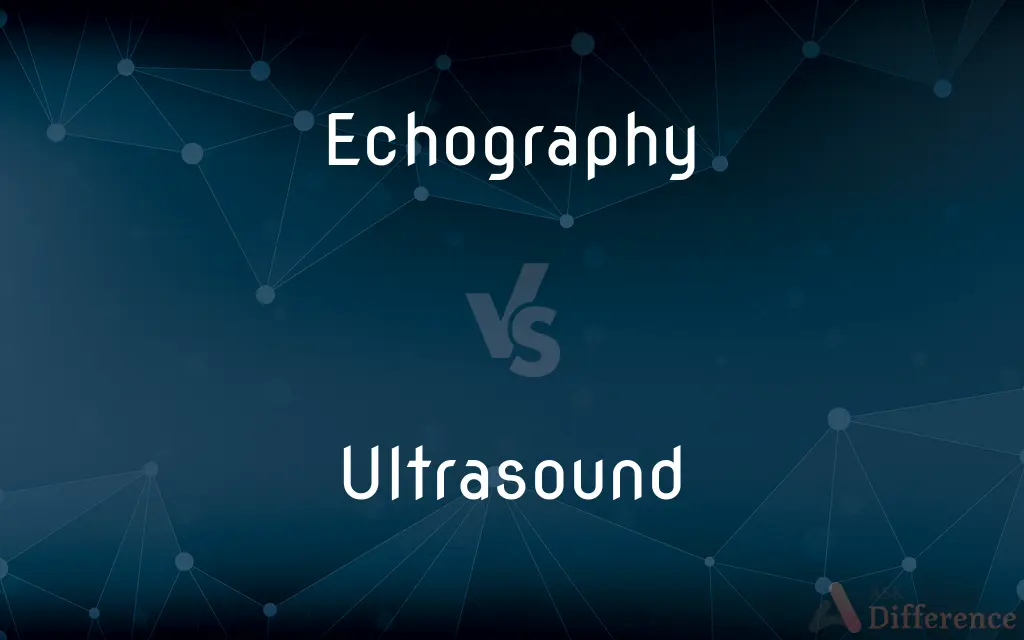Echography vs. Ultrasound — What's the Difference?
By Tayyaba Rehman — Updated on November 4, 2023
Echography is the process of using ultrasound waves for diagnostic imaging; ultrasound is the actual sound wave technology used.

Difference Between Echography and Ultrasound
Table of Contents
ADVERTISEMENT
Key Differences
Echography is a medical imaging technique that utilizes ultrasound waves to produce visual images of the interior of the body. It's specifically the process by which these images are created, often called sonograms. Ultrasound, on the other hand, refers to the sound waves themselves, which have a frequency higher than the audible range for humans and are used in a variety of applications, not just medical imaging.
In medical contexts, echography is employed to view the heart, blood vessels, kidneys, liver, and other organs. It is the method of applying ultrasound technology for diagnostic or therapeutic purposes. The term 'ultrasound' is more general, describing the type of sound wave that echography uses for these imaging purposes.
Echography is often used interchangeably with 'ultrasound scan' in a medical setting, but it is the application of ultrasound technology, not the technology itself. Ultrasound can also be used in non-imaging applications, such as ultrasound therapy for muscle injuries, which would not be termed echography.
Each time a patient is subjected to an echography procedure, they are exposed to ultrasound waves. However, not every use of ultrasound results in an echography. For instance, cleaning devices may use ultrasound waves to remove debris from small items, which is a completely different application of the same kind of waves.
In essence, echography cannot exist without ultrasound, as it is the application of these high-frequency sound waves to create images. Ultrasound is the broader term that encompasses all uses of these sound waves, including but not limited to the medical imaging technique of echography.
ADVERTISEMENT
Comparison Chart
Definition
The use of ultrasound waves for medical imaging.
Sound waves with frequencies above human hearing.
Application
Specifically for diagnostic imaging.
Wide-ranging, including medical and industrial.
Process/Technology
The process of creating images.
The technology of sound production.
Term Usage
Primarily used in a medical context.
Used in both medical and non-medical contexts.
Output
Produces images, called sonograms.
Can produce images or be used for other purposes.
Compare with Definitions
Echography
Imaging technique to visualize internal body structures.
Echography revealed the cause of his abdominal pain.
Ultrasound
Medical imaging that uses high-frequency sound waves to create images of organs.
The ultrasound of his kidney showed stones.
Echography
A non-invasive diagnostic tool using sound wave reflections.
Echography is preferred for its safety profile in prenatal assessments.
Ultrasound
Sound waves with frequencies higher than the upper audible limit of human hearing.
Ultrasound technology has revolutionized prenatal care.
Echography
The process of applying ultrasound for clinical examinations.
She specializes in cardiac echography.
Ultrasound
High-frequency sound used in various industrial and cleaning processes.
They used ultrasound to clean the intricate jewelry.
Echography
A medical procedure using ultrasound waves for internal imaging.
The doctor recommended an echography to check on the baby's development.
Ultrasound
A technology used for detecting objects or measuring distances.
Bats navigate using natural ultrasound.
Echography
Sonographic imaging to detect or monitor medical conditions.
The echography showed that the tumor had not grown.
Ultrasound
Non-invasive sound waves used in therapy and diagnostics.
Ultrasound therapy helped her recover from the muscle injury.
Echography
See ultrasonography.
Ultrasound
Ultrasound is sound waves with frequencies higher than the upper audible limit of human hearing. Ultrasound is not different from "normal" (audible) sound in its physical properties, except that humans cannot hear it.
Echography
(medicine) The use of ultrasound as a diagnostic aid.
Ultrasound
Sound or other vibrations having an ultrasonic frequency, particularly as used in medical imaging
An ultrasound scanner
Ultrasound
Ultrasonic sound.
Ultrasound
The use of ultrasonic waves for diagnostic or therapeutic purposes, specifically to image an internal body structure, monitor a developing fetus, or generate localized deep heat to the tissues.
Ultrasound
An image produced by ultrasound.
Ultrasound
(physics) Sound with a frequency greater than the upper limit of human hearing, which is approximately 20 kilohertz.
Ultrasound
(medicine) The use of ultrasonic waves for diagnostic or therapeutic purposes.
Ultrasound
(ambitransitive) To treat with ultrasound.
Ultrasound
Very high frequency sound; used in ultrasonography
Ultrasound
Using the reflections of high-frequency sound waves to construct an image of a body organ (a sonogram); commonly used to observe fetal growth or study bodily organs
Common Curiosities
What is ultrasound?
It's a type of sound wave with a frequency higher than humans can hear.
Is echography safe?
Yes, it's a non-invasive, safe imaging technique without ionizing radiation.
How does ultrasound work?
It uses high-frequency sound waves that reflect off tissues to create images or effects.
Are echography and ultrasound the same?
Not exactly, echography is a specific application of ultrasound technology.
Who performs an echography?
A trained sonographer or a health care professional with expertise in ultrasound imaging.
What other applications does ultrasound have?
Beyond imaging, it's used for therapeutic treatments and industrial cleaning.
Can ultrasound damage tissues?
Diagnostic ultrasound is generally safe, but excessive exposure can be harmful.
Why would a doctor order an echography?
To diagnose issues with organs, blood flow, or to monitor fetal development.
How often can you have an echography?
As often as needed, as there are no known risks with routine diagnostic use.
Is echography the same as a sonogram?
Yes, the image produced by echography is often called a sonogram.
Can ultrasound waves be heard by humans?
No, they are above the frequency that human ears can detect.
What is echography used for?
For creating images of the inside of the body to diagnose or monitor conditions.
Can anyone operate ultrasound equipment?
No, it requires specialized training to operate and interpret the results.
Is echography only for pregnant women?
No, it's used for a wide range of medical diagnostics, not just obstetrics.
Does ultrasound use radiation?
No, it uses sound waves and not ionizing radiation like X-rays.
Share Your Discovery

Previous Comparison
Cope vs. Drag
Next Comparison
Attendance vs. AttendantAuthor Spotlight
Written by
Tayyaba RehmanTayyaba Rehman is a distinguished writer, currently serving as a primary contributor to askdifference.com. As a researcher in semantics and etymology, Tayyaba's passion for the complexity of languages and their distinctions has found a perfect home on the platform. Tayyaba delves into the intricacies of language, distinguishing between commonly confused words and phrases, thereby providing clarity for readers worldwide.















































